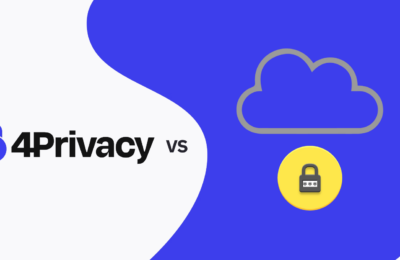
Cloud storage solutions such as Dropbox and Google Drive are used by billions of people across the world, but are they secure?
In this blog, we’ll explore how cloud providers, who use basic encryption and passwords, compare to 4Privacy, who uses end-to-end encryption and no passwords (there’s a difference)!
People who use cloud storage providers like Dropbox can store data online so they can access that data from any device with an internet connection. One of the downsides is that users must rely on Dropbox to secure their information. While Dropbox does encrypt data, their techniques rely on passwords to control access.
Encryption vs End-to-End Encryption
First, let’s cover the basics. The basic definition of encryption is “the process of converting information or data into a code, especially to prevent unauthorized access”. In order to decrypt the information (i.e. make it readable), an encryption key is needed. Anyone with the encryption key can decrypt the data on any device. Most cloud providers own your encryption key, which means they own your data. Additionally, your data is at risk because it is not encrypted at all times.
End-to-end encryption is a particular method of encrypting data between two authorized parties, this method ensures that anyone listening for, or storing this data, such as cloud providers, do not have access. With end-to-end encryption, the key is created on your device and shared privately with those you want to give access to. This means that cloud providers never have access to use, change, or mine your data. Only those who you specifically share the key with can decrypt and access your data.
End-to-end encryption is a far superior method for protecting your information and preventing data breaches. End-to-end encryption is also a big step forward for data privacy.
Most Cloud Storage vs 4Privacy
The other guys
In addition to most cloud providers using different encryption techniques, they also own your encryption key. In order for a user to access their account, they use a username and password. These credentials can be shared, phished or stolen.
4Privacy
4Privacy is built on a foundation for data privacy and security. The app is end-to-end encrypted and YOU are the only person to hold the encryption key, which means no one else can see your data (unless you share it with them). Every file, photo or note you put into the app is automatically end-to-end encrypted, without you having to do a thing! 4Privacy’s customers do not use usernames and passwords. Instead, your physical phone plus a pin or biometric grants you access. This eliminates someone across the room, or the world, from getting into your account. 4Privacy also provides you with an easy to use organization structure to get your life completely organized.
How do you backup your encryption key on the 4Privacy app?
4Privacy gives you two very easy options to backup your key. Your device generates these words, therefore 4Privacy does not have access. You’ll need to backup your key in case you lose your phone, forget your PIN, delete the app, or are otherwise locked out of your account. Within the app, you can choose to print or write down your 24 word account recovery. We recommend that you store your key in a safe place (your lockbox, safe, etc). If you lose these words and you are locked out of your account, 4Privacy cannot help you.
Why is it important that my data is End-to-End Encrypted?
Lots of reasons! To start, your data is automatically encrypted on your device which means it’s protected before it ever hits the airwaves as it heads to the cloud. Next, you don’t have to rely on the cloud provider’s subpar encryption techniques. Additionally, most cloud providers do not give any guarantees that your data won’t be altered or used by the cloud provider. Finally, with end-to-end encryption, only individuals with whom you share the encryption key can view your data.
Conclusion
If you’re looking for a safe, private place to organize your most important information, try 4Privacy for free.
